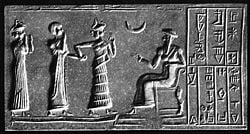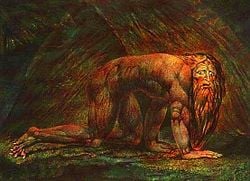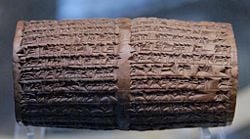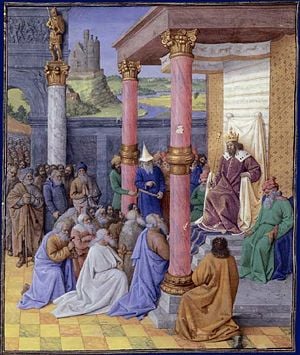Difference between revisions of "Nabonidus" - New World Encyclopedia
m (→External links) |
m (→See also) |
||
| Line 78: | Line 78: | ||
*[[Cyrus the Great]] | *[[Cyrus the Great]] | ||
*[[Book of Daniel]] | *[[Book of Daniel]] | ||
| + | |||
| + | {{start box}} | ||
| + | {{succession box|title=[[Kings of Babylon|King of Babylon]]|before=[[Labashi-Marduk]]|after=[[Nebuchadnezzar IV]] (self-proclaimed)|years=556–539 B.C.E.}} | ||
| + | {{end box}} | ||
==Notes== | ==Notes== | ||
Revision as of 03:55, 2 October 2008
Nabonidus (Akkadian Nabû-nāʾid) was the last king of the Neo-Babylonian Empire, reigning from 556-539 B.C.E. His background is uncertain, but his mother may have been a priestess of the moon god Sin (god), to whom Nabonidus was unusually devoted. He took the throne after the assassination of the boy-king Labashi-Marduk, although it is not clear whether he had a role in Labashi-Marduk's death.
As king, Nabonidus was much maligned by the priests of the chief Babylonian deity Marduk on account of his strong devotion to Sin and his lack of attention to the city's important New Year's festival. During several years of his kingship, Nabonidus was absent at the Arabian oasis of Tayma, during which time his son Belshazzar reigned in his place. The reasons for his long absence remain a matter of controversy, with theories ranging from illness, to madness, to an interest in religious archaeology.
He returned to the capital in time to lead his armies against the ascendant forces of Persia under Cyrus the Great. During this time he gathered various statues of divinities and their priests from his southern and eastern provinces, a policy for which he was later criticized by Cyrus, who returned these artifacts to their previous abodes.
Nabonidus surrendered to the Persian forces in 539 B.C.E. and was apparently allowed to live out his life. The end of his reign marks the beginning of the Persian Empire and the end of the Babylonian captivity of the Jews.
Historiography on Nabonidus
More than with others, our perception of Nabonidus' reign has been heavily coloured by later accounts, notably by the Persians and the Greeks, as well as in the Hebrew Bible. As a result of this, Nabonidus was often described in very negative terms in modern and contemporary scholarship. However, an accumulation of evidence and a reassassment of existing material has caused opinions on Nabonidus and the events that happened during his reign to have altered significantly in recent decades.
Uncertain backgound
In his own inscriptions, Nabonidus himself makes no claim to royal origins.[1] His mother may have been connected to the temple of the moongod Sîn in Harran, but her ancestry is unknown. The fact that Nabonidus makes repeated references to Ashurbanipal, the last great Neo-Assyrian king has been cited as evidence that he may have been of Assyrian origin. However Nabonidus' Persian successor, Cyrus the Great, also referred to Ashurbanipal, as did several of Nabonidus' predecessors.
In any case, it is clear that Nabonidus did not belong to the previous ruling dynasty, the Chaldeans, of whom Nebuchadnezzar II was the most famous member. He came to the throne in 556 B.C.E. by overthrowing the youthful king Labashi-Marduk, the son of Neriglissar. Labashi-Marduk had succeeded his father when still only a boy, after the latter's four-year reign. Most likely due to his very young age, he was considered unfit to rule, and was murdered in a conspiracy only nine months after his inauguration. Nabonidus was consequently chosen as the new king.
Reign

In most ancient accounts, Nabonidus is being depicted as a royal anomaly. He is supposed to have worshiped the moon god Sîn (mythology) beyond all the other gods, to have paid special devotion to Sîn's temple in Harran, where his mother was a priestess, and to have neglected the Babylonian chief god, Marduk. Because of the tensions that these religious reforms generated, he had to leave Babylon early in his reign, residing at the rich desert oasis of Tayma in Arabia, and returning only after many years. In the meantime, his son Belshazzar ruled from Babylon.
Nabonidus' stay in Tayma
Why Nabonidus stayed in Tayma for so long is another matter of uncertainty. His reason for going there is unproblematic enough: Tayma was an important oasis, from which lucrative Arabian trade routes could be controlled. The Neo-Assyrians before him had already attempted the same.
However, why Nabonidus stayed for so long—about ten years, perhaps from 553-543—remains a question, as does his reason for returning at the moment that he did. One theory is that he was not comfortable in Babylon, which was the center of Marduk-worship and was opposed to his emphasis on Sîn.
Another possibility is that he was ill and went to the oasis to recover. In the Dead Sea Scrolls, a fragment known as the Prayer of Nabonidus relates that Nabonidus suffered from an ulcer for seven years, causing him to retreat from civilization:
I, Nabonidus, was afflicted with an evil ulcer for seven years, and far from men I was driven, until I prayed to the most high God. And an exorcist pardoned my sins. He was a Jew from among the children of the exile of Judah... During my stay at Tayma, I prayed to the gods of silver and gold, bronze and iron, wood, stone and lime, because I thought and considered them gods...
This legend may explain a confusing issue in the Book of Daniel, in which the king in question is called Nebuchadnezzer. However, this Nebuchadnezzer's son is named Belshazzar, which was in fact the name of Nabonidus' son, who reigned in his stead while Nabonidus was at Tayma. It may thus be the case that the Book of Daniel confuses Nabonidus with Nebuchadnezzer. However, the Book of Daniel describes its king's disease as a type of madness, rather than an ulcer, saying: "He was driven away from people and ate grass like cattle. His body was drenched with the dew of heaven until his hair grew like the feathers of an eagle and his nails like the claws of a bird."
Regarding his return, this may have had to do with the mounting threat of Cyrus and growing disagreements with Belshazzar, who was relieved of his command directly after Nabonidus returned, along with a number of administrators. During his stay in Tayma, Nabonidus adorned the oasis with a full royal complex, most of which has come to light during recent excavations.
Religious policy
Although Nabonidus' personal preference for Sîn is clear, scholars are divided regarding the degree of his supposed monotheism. Some claim that it is obvious from his inscriptions that he became almost henotheistic, considering Sin exclusively as the national god of Babylon.[2] In the Nabonidus cylinder, the king petitions Sin as follows: “And as for Belshazzar my firstborn son, my own child, let the fear of your great divinity be in his heart, and may he commit no sin; may he enjoy happiness in life."
Others, however, insist that Nabonidus, while personally devoted to Sin, respected the other cults in his kingdom, pointing out that he supported construction works to their temples and did not suppress their worship.[3] In this theory, his negative image is due mainly to his long absence from Babylon during his stay in Tayma, during which the important, Marduk-related New Year festival could not take place, a fact which deeply offended the priests of Marduk. In fact, there is no sign of the civil unrest during Nabonidus' reign, not even during his absence, and he was able to return to his throne and assert his authority no apparent problem.
However, Nabonidus did remove important cultic statues and their attendants from southern Mesopotamia and bring them to Babylon. A number of contemporary inscriptions indicate that these statues and their priests were brought to Babylon just before the Persian attack that brought Cyrus to power:
"In the month of [Âbu?], Lugal-Marada and the other gods of the town Marad; Zabada and the other gods of Kish; and the goddess Ninlil and the other gods of Hursagkalama visited Babylon. Till the end of the month Ulûlu all the gods of Akkad—those from above and those from below—entered Babylon. The gods of Borsippa, Cutha, and Sippar did not enter."|Babylonian Chronicles on the 17th year of the reign of Nabonidus.}}
However, some scholars argue that Nabonidus' motive in bringing these gods to the capital was not to take them hostage, but to ensure that they and their retinue received proper care and protection. In this theory, prior to the Persian conquest of Babylonia in 539 B.C.E., Nabonidus gathered of the traditional gods of Sumer and Akkad into the capital in order to protect them from being carried away or destroyed by the Persians.
Regardless of his motives, however, his actions exposed him to the criticism of his enemies. Thus, when Cyrus entered Babylon, one of his first acts was to demonstrate his piety before Marduk and his support of the local cults, simultaneously denigrating Nabonidus as unfit to rule. He thus returned the statues to their places of origin, affirming in the Cyrus cylinder that he did so in obedience to the command of Marduk, while accusing Nabonidus of having offended the gods by bringing them to Babylon:
As for the gods of Sumer and Akkad which Nabonidus, to the wrath of the Lord of the gods, brought to Babylon, at the command of Marduk, the great Lord, I (Cyrus) caused them to dwell in peace in their sanctuaries, (in) pleasing dwellings."
This is confirmed by the Babylonian Chronicles, which indicate that, "The gods of Akkad which Nabonidus had made come down to Babylon, were returned to their sacred cities."
The Persian conquest
Various accounts survive describing the fall of Babylon during the reign of Nabonidus. According to the Cyrus cylinder, the people opened their gates for Cyrus and greeted him as a liberator. The Isaiah 40-55 prophesies that the Persians would carry off Babylonian women and cultic statues. Herodotus says that Cyrus defeated the Babylonian army outside the city, after which he instituted a siege of city. When this took too long, he diverted the Euphrates, so that his troops could march into the city through the river bed.[4] Xenophon agrees with this, but he does not mention the battle.[5] Finally, Berossus agrees that that Cyrus defeated the Babylonian army after which Nabonidus fled to nearby Borsippa. There he hid, while Cyrus took Babylon and demolished its outer walls. When he turned towards Borsippa, Nabonidus soon surrendered himself.
More helpful is the Nabonidus Chronicle, which is a part of the Babylonian Chronicles—terse, factual accounts of historical events, considered to be reliable, although not very detailed. This text has the following to say on the taking of Babylon by Cyrus:
In the month of Tašrîtu, when Cyrus attacked the army of Akkad in Opis on the Tigris, the inhabitants of Akkad revolted, but he massacred the confused inhabitants. The fifteenth day [October 12], Sippar was seized without battle. Nabonidus fled. The sixteenth day, Gobryas [Ugbaru], the governor of Gutium, and the army of Cyrus entered Babylon without battle. Afterwards, Nabonidus was arrested in Babylon when he returned there.
Additionally, a building inscription has been found that mentions the restoration of the Enlil Gate of Babylon shortly after its capture. Through these data, the following reconstruction may be proposed: When Cyrus attempted to march into southern Mesopotamia, he was met by the Babylonians near Opis. In the ensuing battle, the Persians were victorious, after which they carried a massacre. The nearby city of Sippar, wishing to avoid a similar fate, surrendered without a fight. Meanwhile, Nabonidus had retreated with his Babylonian forces to establish a line of defense near the Euphrates. However, Cyrus did not attack the main force of the Babylonian army, but sent a small division south along the Tigris to take the capital by surprise. This plan worked: the Persian forces reached Babylon undetected and caught the city unawares, meeting only minor resistance near one of its gates. Thus, the Persians were able to capture Babylon. King Nabonidus, unaware that the city had fallen, was captured while attempting to return to the capital.
This left the Babylonian army in a precarious position, and it soon surrendered. In the meantime, Ugbaru, the commander of the division that had captured Babylon, had taken good care that his men would not plunder or otherwise harm the city. Nonetheless, it took Cyrus almost a month before he proceeded toward the city. As many Babylonian officials as well as the Babylonian administrative system stayed in place after the transition of power, it has been surmised that this time was spent on negotiations with representatives from the city.[6] Finally, Cyrus went to Babylon, where he could now have his triumphant entry to the cheers of the people.
Nabonidus' death and legacy
Accounts by Berossus and others mention that Nabonidus' life was spared, and that he was allowed to retire in Carmania. This conforms with other accounts indicating that Cyrus was known for sparing the lives of the kings whom he had defeated when it served his purposes.
Nabonidus successor, Cyrus the Great, brought an end to the Babylonian Empire and initiated the ascendancy of Persia. Cyrus' policy of returning religious artifacts and priests to their home sanctuaries soon extended the empire's western regions as well, as he allowed the Jews to return to Jerusalem with their sacred vessels and begin rebuilding the Temple. Thus, the end of Nabonidus' reign also marks the beginning of the end of the Babylonian exile of the Jews, as well as the beginning of the Persian Empire.
See also
| Preceded by: Labashi-Marduk |
King of Babylon 556–539 B.C.E. |
Succeeded by: Nebuchadnezzar IV (self-proclaimed) |
Notes
ReferencesISBN links support NWE through referral fees
- Beard, Mary, and John A. North. Pagan Priests: Religion and Power in the Ancient World. London: Duckworth, 1990. ISBN 9780715622063
- Beaulieu, Paul-Alain. The Reign of Nabonidus, King of Babylon, 556-539 B.C.E. Yale Near Eastern researches, 10. New Haven: Yale University Press, 1989. ISBN 9780300043143
- ________________. Legal and administrative texts from the reign of Nabonidus. Yale oriental series, v. 19. New Haven: Yale University Press, 2000. ISBN 9780300057706
- Crawford, Harriet E. W. Regime Change in the Ancient Near East and Egypt: From Sargon of Agade to Saddam Hussein. Proceedings of the British Academy, 136. Oxford: Oxford University Press for The British Academy, 2007. ISBN 9780197263907
- Dougherty, Raymond Philip. Nabonidus and Belshazzar; A Study of the Closing Events of the Neo-Babylonian Empire. New Haven: Yale University Press, 1929. OCLC 1219782
- Lambert, W. G. Nabonidus in Arabia. London: Seminar for Arabian Studies, 1972. OCLC 83194073
- Smith, Sidney. Babylonian Historical Texts: Relating to the Capture and Downfall of Babylon. New York: G. Olms, 1975. OCLC 3179020
External links
- Nabonidus Cylinder from Sippar Translation.
- Nabonidus Cylinder from Ur Translation.
Credits
New World Encyclopedia writers and editors rewrote and completed the Wikipedia article in accordance with New World Encyclopedia standards. This article abides by terms of the Creative Commons CC-by-sa 3.0 License (CC-by-sa), which may be used and disseminated with proper attribution. Credit is due under the terms of this license that can reference both the New World Encyclopedia contributors and the selfless volunteer contributors of the Wikimedia Foundation. To cite this article click here for a list of acceptable citing formats.The history of earlier contributions by wikipedians is accessible to researchers here:
The history of this article since it was imported to New World Encyclopedia:
Note: Some restrictions may apply to use of individual images which are separately licensed.




